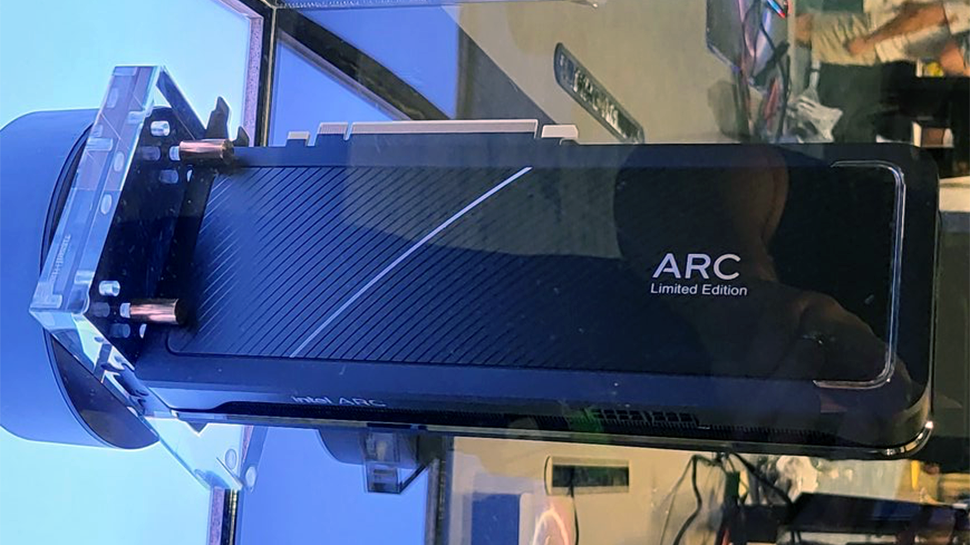Intel Finally Shows Off Actual Arc Alchemist Desktop Graphics Card
Intel displays Arc Alchemist 700-series desktop graphics board
In the past few months, Intel has talked quite a lot about its upcoming discrete graphics cards for desktop PCs, without actually showing them in person--at least until now. At its Intel Extreme Masters pro gaming tournament in Texas today, the company demonstrated its Arc Alchemist 700-series board, powered by the ACM-G10 GPU. Only time (and lots of our testing) will tell if this card or one of its variants earns a spot on our best graphics cards for gaming list.
Specifically, the card that Intel showcased at IEM is called the Intel Arc Limited Edition. It was photographed and Tweeted by Bryce_GfxDriverGuru, an Intel Arc Community Advocate, so consider the demonstration official. Intel demonstrated a rendering of its Arc Limited Edition graphics board back in March, and has revealed some important details about the product.
First up, we know that the board is based on the 'big' Arc Alchemist GPU known as the ACM-G10, and it features up to 32 Xe cores (or 4096 stream processors, if you wish). Secondly, we also know that the graphics processor is paired with 16GB of GDDR6 memory. Thirdly, the board has four DisplayPorts and one HDMI port.



One of the mysteries about the Arc Limited Edition product is whether it is powered by the Arc Alchemist A770 or the A780 GPU model. The latter is obviously the fastest of the two, but whether is used on the Limited Edition model is something that even our the folks at VideoCardz, who tend to keep their ears close to the ground, do not seem to know.
As the name of the board suggests, the Intel Arc Limited Edition will be sold under the Intel brand and in limited quantities. The board uses a dual-slot, dual-fan cooling system and has eight-pin and a six-pin auxiliary PCIe power connectors that can deliver up to 225W of power in total (in addition to the up to 75W delivered using a PCIe x16 slot itself), so it clearly the card is not as hot and power-hungry as flagship solutions from AMD and Nvidia.
Intel has not announced recommended prices of its Arc Alchemist A700-series desktop graphics cards yet. But if its flagship A770/A780 models are set to compete against Nvidia's GeForce RTX 3070 or RTX 3080 boards, they'll need to be priced competitively. And with the price of existing graphics cards falling fast month over month, the longer Intel waits to ship its cards, the lower that price will likely have to be if it hopes to grab a serious chunk of the gaming GPU market.
Get Tom's Hardware's best news and in-depth reviews, straight to your inbox.

Anton Shilov is a contributing writer at Tom’s Hardware. Over the past couple of decades, he has covered everything from CPUs and GPUs to supercomputers and from modern process technologies and latest fab tools to high-tech industry trends.
-
InvalidError Between ARC being 7+ months late, its seemingly on-going driver issues and next-gen GPU launches being almost right around the corner, I'll be curious to see how Intel is going to have to price them to gain any sort of retail traction if it doesn't give up on retail launch altogether first. Goodbye former plans to sell over 4M units in 2022!Reply -
RodroX I agree with what InvalidError wrote up there.Reply
But I do not care if they are late to the show, or if the price is low or high. I just wana see actual product on the shelves, how they perform vs competition, how much power they really draw and how good/bad the drivers are on launch date. Not to mention how its build, how are materials, finish, etc.
Anyways, cheers!!!
Edited (I forgot the "but") -
DavidC1 ReplyInvalidError said:Goodbye former plans to sell over 4M units in 2022!
This isn't super hard as they said it'll earn $300 million revenue meaning ASP of $75. An average selling price of $75 means you have products lower than $75. This means lot will be on low end cards like ARC 3, especially mobile. -
InvalidError Reply
When VRAM costs $8-10 per GB and a 100sqmm die costs ~$20, Intel would need to sell ARC at a loss to hit $75 ASP.DavidC1 said:This isn't super hard as they said it'll earn $300 million revenue meaning ASP of $75. An average selling price of $75 means you have products lower than $75. This means lot will be on low end cards like ARC 3, especially mobile.
Intel eating losses to break into a new market would be within my expectations. -
jkflipflop98 ReplyInvalidError said:Intel eating losses to break into a new market would be within my expectations.
That's pretty much the basics of any business. You want to break into a new market, you're going to have to give up something to compete. -
InvalidError Reply
Looking at the pretty steep prices on all laptops featuring even the bottom-end ARC GPU so far though, it doesn't look like Intel is letting them go for $75 a pop on average.jkflipflop98 said:That's pretty much the basics of any business. You want to break into a new market, you're going to have to give up something to compete. -
lanceton I'm going to switch as long as Intel's not too far behind compared to Nvidia and AMD's.Reply
Sick of the video card shortage situation which these two companies are partly to blame. -
jacob249358 Reply
Intel isnt going to be any nicer. From what I have seen people on this forum talk about it sounds like intel is actually the scummiest of the 3. (I dont personally care cause they have to make money and thats how it is)lanceton said:I'm going to switch as long as Intel's not too far behind compared to Nvidia and AMD's.
Sick of the video card shortage situation which these two companies are partly to blame.